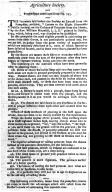[ On the Culture of Potatoes from the Shoots ] Rev. William Maunsell
Date: 1795/05/14
Source:
Halifax Journal
Institution: Nova Scotia Archives
| Source Origin: Nova Scotia Newspapers on Microfilm
| Reference: Microfilm Reel 8165
Directions for planting potatoes from shoots instead of seed potatoes. Vol. 15, No. 745. The author of "Cultivation of Potatoes" published in the Royal Gazette and the Nova Scotia Advertiser may refer to the original, which was published in Dublin in 1794.
Agriculture Society.
__
Proceedings continued from No. 743.
__
THE Secretary laid before the Society an Extract from the
Pamphlet, entitled, “Letters to the Right Honorable
“Dublin Society, on the Culture of Potatoes from the Shoots,
“by the Rev. William Maunsell, L. L. D.” printed in Dublin,
1794, which, being read, was directed to be published.
In this pamphlet the most eligible process in cultivating po-
tatoes from their shoots, is not particularly pointed out, but
we are left to judge from the great variety of experiments
which are minutely described in it, none of which seemed to
have failed of success, and in some ever shoot planted has been
productive.
By the shoots are meant those fibres or branches which im-
mediately grow from the eyes of the potatoes after they have
begun to vegetate without being put into the earth.
The following are the methods which have been generally
used in planting them:
1st. Drills of about six inches deep and two feet apart from
each other are made in ground previously prepared in the usual
way. Potatoe shoots are then cut into lengths of about five
or six inches each, and planted in the drill six inches asunder,
with their thickest ends, or those that have been next to the
potatoe, downwards. They are then covered with earth about
one inch under.
Or 2d. A furrow is made with a plough, some dung spread
in it--the furrow is closed back with the plough, and the
shoots planted in it as you would do cabbages with setting
sticks.
Or 3d. The shoots are laid down in any direction in the fur-
row at proper distances from each other and covered with the
plough.
Which of those methods of planting is the best upon the
whole, does not seem to be clearly decided by the experiments.
When the stocks appear above ground, keep earthing them
up at least eighteen inches high, leaving always about two or
three inches above ground, “for,” says the author, “the high-
er you earth them up, the greater will be the produce; for the
potatoes from the shoots, if properly attended to, will not
spread in the ground, but ascend to the surface, as you may see
them when dug out growing to the stuck as Onions tied to a
trace.”
The superior advantage of raising potatoes from the shoots
instead of the potatoes themselves, are the following:
1st. The seed potatoes, which in Ireland are reckoned to be
one sixth of the whole crop, are a clear saving.
2d. The same space of ground will produce twice or three
times the quality.
3d. The growth is more vigorous. The produce earlier
and of a better quality.
4th. The labour of cutting the seed potatoes into what are
called sets of scullains, is also saved.
5th. It is probable they will not be so apt to degenerate as
in the old way of raising them.
___
The following certificates, taken from the pamphlet, leaves
no room to doubt the advantages which will result from the
Doctor’s mode of cultivating this valuable root.
Download: Transcription | Images
